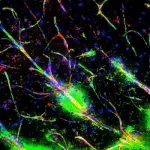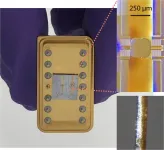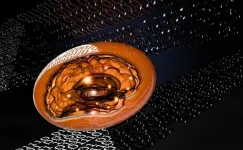(Press-News.org) Like a stern bodyguard for the central nervous sytem, the blood-brain barrier keeps out anything that could lead to disease and dangerous inflammation--at least when all is functioning normally.
That may not be the case in people with schizophrenia and other mental disorders, suggest new findings from a team led by researchers from the School of Veterinary Medicine, Perelman School of Medicine, and Children's Hospital of Philadelphia (CHOP). In these individuals, a more permissive barrier appears to allow the immune system to get improperly involved in the central nervous system, the researchers showed. The inflammation that arises likely contributes to the clinical manifestations of neuropsychiatric conditions.
"Our hypothesis was that, if the immune function of the blood-brain barrier is compromised, the resulting inflammation will have an impact on the central nervous system," says Jorge Iván Alvarez, an assistant professor at Penn Vet and senior author on the work, published in the journal Brain. "With that in mind, we think these findings could also be used to understand how the blood-brain barrier and neurological processes impact not only schizophrenia but mental disorders at large."
The research team pursued the study focused on a rare condition called 22q11.2 deletion syndrome (22qDS), in which people are born missing a small portion of DNA from chromosome 22. Roughly a quarter of people with this syndrome go on to develop schizophrenia. Penn and CHOP have a community of researchers who study the condition, often as a way of probing deeper into the mysteries of schizophrenia.
This disorder had not been a focus for the Alvarez lab, however, until he gave a talk at CHOP on his area of expertise--the blood-brain barrier--and was approached by an attendee afterward.
"We started talking about the fact that, in this deletion syndrome, one of the missing genes is very important for blood-brain barrier function," Alvarez says.
That attendee, Stewart Anderson of CHOP, had been studying 22qDS, and together he and Alvarez began collaborating to evaluate whether the blood-brain barrier and its effect on the immune system were playing a role in the condition.
As a first step, the group used a technique whereby stem cells from 22qDS patients diagnosed with schizophrenia, as well as healthy controls, are coaxed to develop into blood-brain barrier endothelial cells, the cells that form a tightly regulated "wall." In experiments led by Vet School doctoral student Alexis Crockett, they found that the barrier function in cells derived from 22qDS patients was more impaired than those derived from the healthy controls, which were more restrictive. They confirmed these findings in mice bred to have a version of 22qDS, finding that their blood-brain barrier was likewise leaky compared to normal mice.
The brain is typically considered "immune privileged," meaning that the surveillance carried out by immune cells and immune mediators on the central nervous system is not only regulated by the physical blockade of the blood-brain barrier but also by endothelial cells making the barrier express lower levels of immune signaling molecules.
To see if 22qDS compromised this immune privilege, the researchers again looked to patient stem cells induced to grow into blood-brain barrier cells and to their mouse model. In both cases, they observed impairments in the immune privilege properties of the barrier, with more immune cells and pro-inflammatory molecules able to cross it.
As a final validation of their findings, the researchers examined post-mortem brain tissue from three 22qDS patients and three controls. Similar to their work in cultured cells and the mouse model, they found evidence of impairment in the blood-brain barrier's physical and immune protective functions.
"This was the corroboration process, replicating all of these observations in human tissues," Alvarez says.
The work adds to a growing body of evidence suggesting that schizophrenia and certain other neuropsychiatric conditions may be in part neuroinflammatory disorders. It's also the first study to assess blood-brain barrier function in 22qDS, making an important link between neuroinflammation due to barrier dysfunction and neuropsychiatric disorders.
"Because 25% of 22q patients develop schizophrenia, it may be possible that these mechanisms taking place in 22q are applicable to idiopathic schizophrenia," Alvarez says. "And when 22q patients are studied in detail, up to 80% are found to have some form of mental disorder, so these findings may well extend to other disorders as well," including perhaps depression or autism, he says.
In future work, Alvarez and colleagues will be exploring the role of the blood-brain barrier further, narrowing in on what processes are involved in the barrier's increased permeability, including a look at astrocytes, cells that normally enhance barrier function.
Further insights into the connection between inflammation and neuropsychiatric disease, Alvarez says, may one day lead to therapies that address inflammation by manipulating the immune response.
INFORMATION:
Alvarez's and Anderson's coauthors, from Penn Vet, the Children's Hospital of Philadelphia, and the Perelman School of Medicine, were Alexis M. Crockett, Sean K. Ryan, Adriana Hernández Vásquez, Caroline Canning, Nickole Kanyuch, Hania Kebir, Guadalupe Ceja, James Gesualdi, Elaine Zackai, Donna McDonald-McGinn, Angela Viaene, Richa Kapoor, Naïl Benallegue, Raquel Gur, and Stewart Anderson. Alvarez was senior author, and Crockett was first author.
Jorge Iván Alvarez is an assistant professor in the Department of Pathobiology at the University of Pennsylvania School of Veterinary Medicine.
Stewart Anderson is a professor in the Department of Psychiatry at Penn's Perelman School of Medicine and director of Research for the Department of Child and Adolescent Psychiatry and Behavioral Services of the Children's Hospital of Philadelphia.
Alexis Crockett is a doctoral student at Penn's School of Veterinary Medicine.
The study was supported by the National Institutes of Health (grants 5K01NS097519-03, MH110185-03, MH066912, MH191719, MH087636, MH119738, MH119219, and MH101719) and the Penn/CHOP Lifespan Brain Institute.
WASHINGTON -- Researchers have developed new x-ray optics that can be used to harness extremely fast pulses in a package that is significantly smaller and lighter than conventional devices used to modulate x-rays. The new optics are based on microscopic chip-based devices known as microelectromechanical systems (MEMS).
"Our new ultrafast optics-on-a-chip is poised to enable x-ray research and applications that could have a broad impact on understanding fast-evolving chemical, material and biological processes," said research team leader Jin Wang from the U.S Department of Energy's Argonne National Laboratory. "This could aid in the development of more efficient solar cells and batteries, advanced computer storage materials and devices, ...
Engineered, autonomous machines combined with artificial intelligence have long been a staple of science fiction, and often in the role of villain like the Cylons in the "Battlestar Galactica" reboot, creatures composed of biological and engineered materials. But what if these autonomous soft machines were ... helpful?
This is the vision of a team of Penn State and U.S. Air Force researchers, outlined in a recent paper in Nature Communications. These researchers produced a soft, mechanical metamaterial that can "think" about how forces are applied to it and respond via programmed reactions. ...
People who regularly use psychoactive substances report experiencing a variety of negative impacts since the COVID-19 pandemic began, including increased usage and fear of relapse or overdose, highlighting the need for improved supports and services, including better access to safe supply programs, according to a new CAMH survey published in the International Journal of Drug Policy.
"People who use drugs have been negatively impacted by the pandemic in ways that put them at greater risk for experiencing substance and health-related harms, including overdoses and a decreased ability to mitigate risk behaviours," ...
Leesburg, VA, April 20, 2021--An award-winning Scientific Electronic Exhibit to be presented at the ARRS 2021 Virtual Annual Meeting found non-contrast pituitary MRI for central precocious puberty (CPP), growth hormone deficiency (GHD), and short stature (SS) has similar diagnostic yield compared to the standard contrast-enhanced protocol.
"Microadenomas, a common justification for contrast administration, may not influence management in this patient population," wrote first author Jennifer Huang of Vanderbilt University in Nashville, TN, adding "minimal inconvenience would be added for the few patients who would need to return for contrast-enhanced MRI for definitive diagnosis."
Huang and colleagues performed a retrospective review of pediatric pituitary MRI studies from 2010-2019 ...
Leesburg, VA, April 20, 2021--An award-winning Scientific Electronic Exhibit to be presented at the ARRS 2021 Virtual Annual Meeting found no statistically significant threshold for increased renal transplant biopsy risk based on systolic (SBP), diastolic (DBP), or mean arterial (MAP) blood pressure alone.
"When these metrics are combined," first author Winston Wang of the Mayo Clinic Arizona cautioned, "the risk of complication is significantly higher when the SBP is >= 180 mm Hg, DBP is >= 95 mm Hg, and MAP is >= 116 mm Hg."
Wang and team's review of consecutive ...
Researchers have found a causal link between caesarean section birth, low intestinal microbiota and peanut sensitivity in infants, and they report the effect is more pronounced in children of Asian descent than others, in a recently published paper in the journal of the American Gastroenterological Association.
"It's important to know what predicts or increases risk of food sensitivities because they predict which infants will go on to develop asthma and other types of allergies," said Anita Kozyrskyj, pediatrics professor in the University of Alberta's Faculty of Medicine & Dentistry ...
Professor Bin He's team at Carnegie Mellon University, in collaboration with the Mayo Clinic, has discovered that fast oscillations in scalp-recorded electroencephalography can pinpoint brain tissues responsible for epileptic seizures. The collaborative research, recently published in the Proceedings of the National Academy of Sciences (PNAS), leverages noninvasive EEG technology along with the development of a novel machine learning algorithm to automatically identify and delineate concurrent high-frequency oscillations and epileptiform spikes, a key link related to epilepsy. In the near future, these findings may be harnessed to rethink imaging and treatment options for epilepsy patients.
More than ...
An expansive project led by Michigan State University's Lars Brudvig is examining the benefits, and limits, of environmental restoration on developed land after humans are done with it.
Experts estimate there are up to 17 million square miles of land worldwide that have been altered by humans -- through cultivation say -- and then abandoned. That's more than four times the size of the continental United States.
Once humans change a landscape, their impacts linger long after they've moved on. However, humans can heal some of that damage by working to restore the land to its natural state. ...
The familiar murkiness of waters in the Gulf of Mexico can be off-putting for beachgoers visiting Galveston Island. Runoff from the Mississippi River makes its way to local beaches and causes downstream water to turn opaque and brown. Mud is one factor, and river runoff is another. However, concern tends to ratchet up a notch when pollution enters the river runoff discussion on a national scale, specifically when smaller, navigable intrastate bodies of water push pollution into larger interstate waters often involved in commerce (i.e. the Mississippi River, Great Lakes, Ohio River).
A recently published research analysis in the journal Science, co-authored by Victor Flatt, Dwight Olds Chair in Law at the University of Houston Law ...
Published in the Advanced Functional Materials, University of Minnesota researcher Hongbo Pang led a cross-institutional study on improving the efficacy of nucleotide-based drugs against prostate cancer and bone metastasis.
In this study, Pang and his research team looked at whether liposomes, when integrated with the iRGD peptide, will help concentrate antisense oligonucleotides (ASOs) into primary prostate tumors and its bone metastases. Liposomes are used as a drug carrier system, and ASOs are a type of nucleotide drug.
More importantly, they investigated whether this system helps more drugs across the vessel wall and deeply into the tumor tissue. This is critical because, although nucleotide drugs offer unique advantages ...








